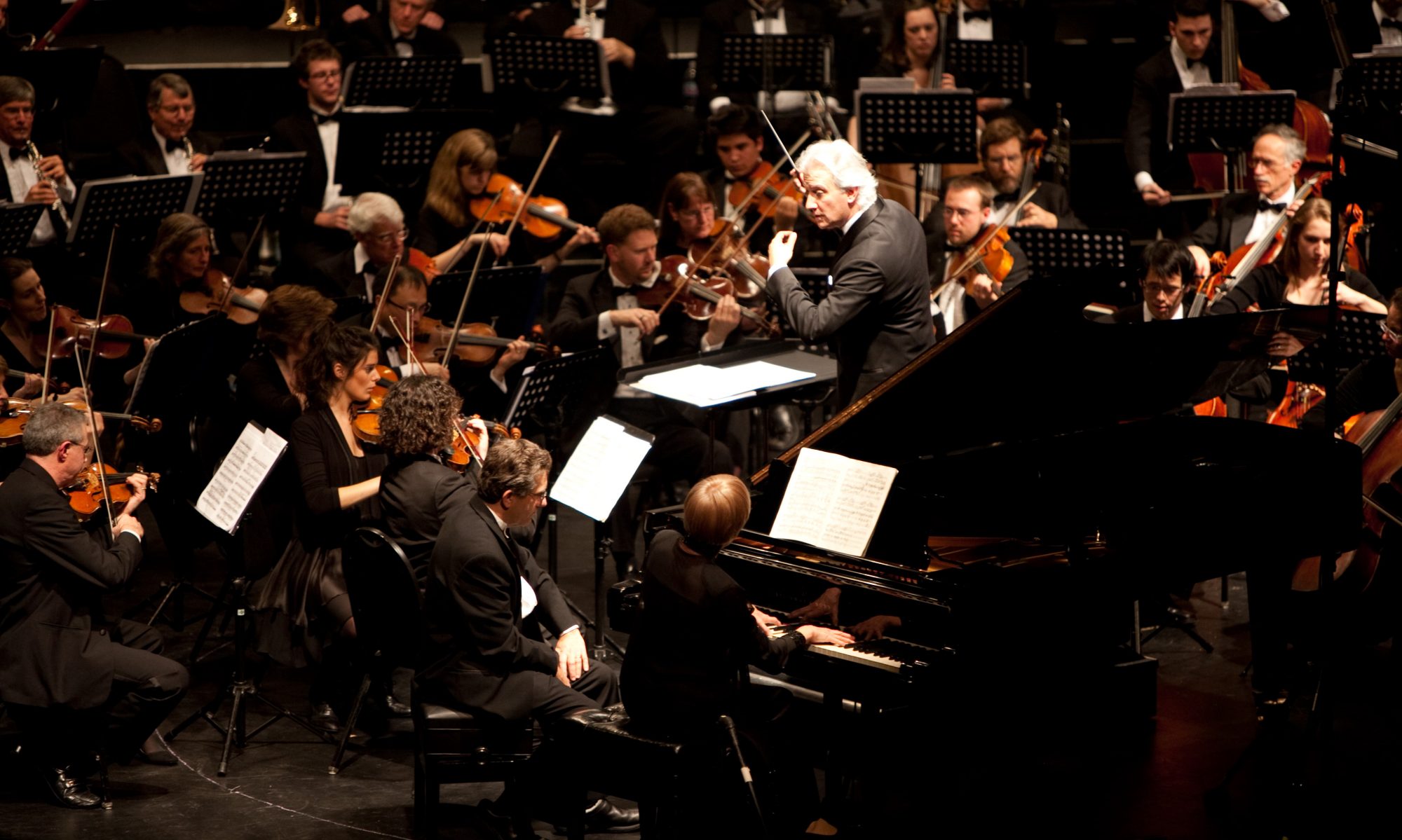At least once per year, many of us who play in orchestras must undergo the time honored summer ordeal called the Great American Outdoor Pops Concert. You know the gig. It’s the one where you and your instrument are exposed to the elements – direct sunlight, extremes in humidity and heat or cold (or in California both simultaneously!) and varying amounts of wind which at times threatens to blow over the music stands! Usually the experience is accompanied by traffic, airplanes and other noises, a complete absence of acoustical reverb and resonance, and a stage setup designed to make it impossible to hear anyone else on stage except yourself, the four people that surround you and the ever-present brass. Some venues provide a tent enclosure or sunshade and on-stage monitors to ameliorate the discomfort. But even under the best conditions, it can be a difficult, scary and uncomfortable way to make music.
If you’re seated in the audience, all the musical sound is coming directly from in front of you. There are no reflections coming from the sides and from above, as there would be in a well-designed concert hall because there are no walls or ceiling to reflect against. There is no reverberation to smooth over the rough edges and artfully blend the tones of the individual instruments. These are not great psycho-acoustic conditions for immersing yourself in the oceanic sound of a symphonic orchestra.
It gets worse. Because there are no supporting reflections to listen to, the direct sound of the orchestra diminishes exponentially as you move from the front to the back of the venue. A strong fortein Row A becomes a barely audible pianoin Row DD. To compound the problem, the level of random noise occurring around you, called the ambient noise floor, is very high compared to the softest sounds the orchestra can make. In an outdoor venue, the ambient noise floor may be so loud that even the whole orchestra playing mezzo-forteis just barely detectable over the noise at an average listening position. So what is there to do? Amplify, my friend, amplify!
That word sends waves of disgust through many classically trained musicians. The thought of sending the pure unadulterated tone of your very expensivewonder from Cremona through a cold, heartless contraption that only yesterday blasted out the latest hip-hop, boy band, rock-a-billy, accordion music from the hearts of space is enough to have many of us pack up and go home. And with good reason. Most of the amplified concerts we have participated in or have heard probably sounded canned, loud and irritating. They were likely produced by audio technicians who had no idea what an orchestra should sound like and didn’t have the technical background to implement a system that could create a realistic symphonic sound. This is no fault of theirs. There’s been little call for those skills until recently.
The exacting requirements posed by orchestral sound reinforcement have never been so in demand as they are today, and the demand is ever increasing. Broadway pit orchestras, opera, ballet, and other small orchestras playing large orchestra repertoire all have insufficient numbers of strings to balance the winds, brass, electronics and percussion. How do you make a good tutti sound with too few strings? Playing louder isn’t the answer. This makes for a skinny, strident, insensitive string sound that undermines any but the most broad expressive gestures. The answer: again, amplify – but using a method that preserves and enhances the subtlety and beauty of the natural sound of the orchestra.
To create a new paradigm for reinforcement systems that would allow for a realistic orchestral sound, we must look at what makes an orchestra sound like an orchestra. If you consider the physical reality of an orchestra, you could view it as a constellation of sound sources, separated in space, left to right and front to back, and spread out over a large angle from the left to the right of a listener seated out in the audience. Each instrument is perceived by the listener at a different distance and angular position. If there are few reflections in the environment, like our example of an outdoor concert, the listener would be able to resolve the location of each player with good accuracy, unless they were very far away, decreasing the angle from left to right. The oceanic sound of an orchestra is created by 50 to 100 independent sound sources combining together at the listener’s ears. This amazing complexity can be “sorted out” by a trained listener’s brain, as in listening to one person speaking at a party with many other people talking simultaneously. For the less trained brain, the sounds tend to blend but are almost at the level of individual cognition. The effect is choral, alive and very dynamic – uniquely orchestral.
In a normal sound reinforcement system, dozens of inputs are separately controlled by a mixing engineer and then combined into one or two main channels that are amplified and distributed to the audience through stacks of high power loudspeakers. This is great for solo instruments or voice, but gets increasingly more and more “canned” sounding as the subtlety and complexity of the signal goes up. Said another way, if you’ve got many sound sources, cramming them into one or two speakers isn’t going to work. It collapses the richly complex sound field of the orchestra into one or two sources.
There’s another reason why this sort of arrangement doesn’t sound real. The obviously audible difference between a great violin and a mediocre violin is often measured in smaller than 1 dB differences between the partials of their tones. Most really excellent high-powered systems are nowhere near accurate enough in phase and frequency to reproduce even one violin without altering the tone. Their inaccuracies act as tonal filters that color everything with the same tonal cast. Now imagine a whole orchestra being passed through that identical tonal filter. Each individual voice will be colored the same way. Flutes will tend to sound like clarinets that will tend to sound like horns. Violas will sound like cellos (Saints preserve us!) The timbral complexity of the orchestra will tend to be collapsed towards one monotonous color. Is it any wonder that the music sounds canned?
A final reason that normal sound systems can’t work well with orchestras is that they are designed, implemented and mixed by people who don’t know what orchestras sound like. Anyone who has conducted or produced an outdoor concert with hired guns from the live sound trade will have horror stories to tell. Suffice it to say that the subtleties of balance between instruments and sections should be executed by the people who do it best – the musicians themselves.
So, how do we implement a sound reinforcement system for an outdoor orchestra concert that satisfies the requirements outlined above? Like this…
- Use at least 50 separate loudspeakers and amplification channels, one channel for each instrument or two, spread out across the stage on overhead trusses to maximize spatial complexity. Each speaker/amplifier channel must
- cover the audience,
- be powerful enough to reproduce the dynamic range of one or two instruments at the back row of the audience,
- have the bandwidth and accuracy to accurately reproduce the range and timbre of the instrument. This is not hard to do given that you are reproducing only one instrument, not dozens.
- Use very low coloration omnidirectional microphones mounted on or close to each instrument and a high definition audio signal path.
- No mixing allowed. The signals go direct to their individual amplifier and speaker.
- For instruments like horn, tuba and timpani that require reflecting off acoustical surfaces to sound well, provide baffles and reflectors and mike the reflected waves.
- Provide acoustical ambience for the players and audience.
- Surround the stage with reflective surfaces, especially putting a lid over the ensemble. Outdoors, half the sound power of the orchestra reflects off the floor. (2 pi steradians) Providing a reflective roof over the orchestra will enable them to hear themselves and direct 3 dB more sound energy towards the audience.
- Surround the audience, above and on all sides, with an array of small monitors that reproduce the output of psycho-acoustically correct reverb generators. Generated reverberation!
- This type of system is in use in many concert halls around the country to enhance existing architectural acoustics.
Experimental systems like the one described above are in development. Using current digital technologies, it is now possible to play Mahler symphonies beautifully and powerfully with 50 players, quadrupling the number of string voices onstage. It is now also possible to hear the richness, beauty and magic of an orchestral performance outside in the open air. As we have in the past, music and musicians will co-opt the technologies of the day to enhance and expand the power and beauty of the orchestra. If we are courageous enough to imagine it, it can become so.
It is possible that outdoor concerts in the summer months could be beautiful and musically satisfying. Are you ready?
###

